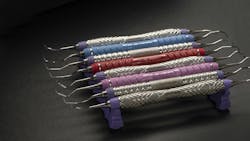Sharpness matters: Surveying hygienists’ instrument use and challenges
The dental hygiene community depends on manual and power instruments to provide effective, safe, and comfortable care. To help better understand how hygienists are using instruments, what their struggles are, and how they choose which instruments to use, RDH magazine recently conducted a survey on instrument sharpening and ergonomics.
The responses held some surprising insight into what hygienists want—and maybe currently don’t have—from their instruments, as well as how younger and older clinicians compare. We hope you enjoy digging into these results!
A bit of high-level stuff: 473 hygienists responded to our survey. A large proportion are clinical veterans, but the time in practice was generally well distributed across respondents. The majority (69%) worked at single-location private practices.
The vast majority of respondents were confident in their scaling techniques and knowledge of ergonomics, with results being similar across all career stages. Ninety-eight percent were either very confident or somewhat confident in scaling technique, and 96% were either very confident or somewhat confident in their knowledge of proper scaling ergonomics and posture. Only 6% of respondents felt moderate or severe pain when performing manual scaling.
The full report, including graphs, is available to download at the end of the article.
Key findings: Sharpness
When asked about main struggles with hand instrumentation (figure 1), the most frequently reported was “finding time to sharpen.” When our respondents shopped for instruments, handle width and sharpness were essentially tied for first place (75% and 73%, respectively).
We also asked respondents if they were using instruments past their functional use. Just over half (55%) responded that they were, and 10% said they weren’t sure. Using dull or aged instruments requires more force on the part of the clinician, increasing the risk of occupational injury, and decreasing patient comfort. Dull instruments also lead to burnished calculus.
Help the office understand that dull instruments decrease production, and complete calculus removal still may not be achieved.
Considering that no one wants to use a dull instrument, why is this happening? Unsurprisingly, money is often at the root of the issue. When asked why they were using old instruments, 23% said their employer wouldn’t provide new ones, and 21% reported that the annual instrument budget had been spent. Note that we conducted this survey four months into the year!
But in a sense, being “time poor” was also a big issue—32% of respondents said they hadn’t gotten around to ordering new instruments. A few respondents also answered that they were too shy to ask for new instruments, or that they were waiting to place a retipping order, or that they were trying to find a way to recycle them.
Considering that sharpening takes time, and ordering more instruments also requires some time, we were surprised sharpen-free instruments were not more popular. For example, only 33% said that they considered whether an instrument was sharpen-free when shopping. A good topic for a future survey would be to drill into clinicians’ perceptions of sharpen-free instruments.
How can hygienists make the case for buying new instruments, or even simply maintaining what they already have?
RDH consultant Annie Walters, MSDH, RDH, has some insight. “Time constraints, office budgets, and limited confidence when sharpening are all factors that have a negative influence on hygienists working with sharp instruments. Help the office understand that dull instruments decrease production, and complete calculus removal still may not be achieved. If setting aside time for sharpening is not an option, provide alternative options to the office, such as using a sharpening service or using sharpen-free instruments. Although some of these items may require more funding initially, clinicians will be more efficient, and can be confident in their instrumentation technique knowing that they do not have to stress their body further to remove calculus with a dull instrument.”
Newer vs. more experienced
Our survey respondents were somewhat evenly divided in terms of their career stages. Comparing years of experience offered some interesting insights.
- Hygienists who had only been in practice a few years were the most likely to report feeling somewhat confident in their scaling technique and ergonomic knowledge, but confidence quickly leveled out with years of experience. Hygienists with 0-10 years of experience were most likely to report discomfort while performing manual scaling.
- Struggles with hand instrumentation were for the most part similar across all experience groups, but early career RDHs were more likely to identify “adaptability of the blade to the tooth” and “ability to reach deep subgingival deposits” as their main issues.
- RDHs of all levels were highly likely to say sharpness was very important when shopping for instruments, and overall, preferences didn’t tend to vary widely between the groups. Hygienists with fewer years of experience were more unsure if their instruments were past functional use.
Download the exclusive full report, including infographics.
Conclusion
RDH magazine’s survey on instrument sharpening and ergonomics illuminates critical instrumentation challenges within the dental hygiene community. The struggle to maintain instrument sharpness emerged as a prominent issue, underscoring the need for streamlined maintenance processes. Hygienists earlier in their careers should especially consider continuing education or peer support to increase their confidence in scaling technique and correct ergonomics. Stay sharp, hygienists!
This survey was supported by HuFriedyGroup.
Editor's note: This article appeared in the June 2024 print edition of RDH magazine. Dental hygienists are eligible for a complimentary print subscription. Sign up here.
About the Author
Amelia Williamson DeStefano, MA
Amelia Williamson DeStefano, MA, is group editorial director of the Endeavor Business Media Dental Group, where she leads the publication of high-quality content that empowers oral-health professionals to advance patient well-being, succeed in business, and cultivate professional joy and fulfillment. She holds a master's in English Literature from the University of Tulsa and has worked in dental media since 2015.
Updated May 16, 2023


